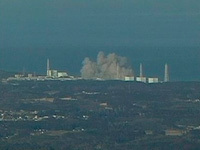이 러시아 과학자((Yaroslav Shtrombach, first deputy director of Kurchatovsky Institute) 는 체르노빌 보다는 1979년 일어난 미국 쓰리마일 섬 원전사고와 보다 유사하다고 주장
http://english.pravda.ru/news/hotspots/12-03-2011/117177-japan_fukushima_chernobyl-0/
Chernobyl-like disaster in Japan impossible, Russian scientists say
 There
There
can be no Chernobyl-like disaster at the nuclear plant in Japan, “since
there is no graphite there, so there is nothing to burn there,” a
Russian academician said.
Academician Yevgeny Velikhov, from
Kurchatovsky Institute think tank, said that at Fukushima-1 plant in
Japan there were pressurized water-cooled reactors of Japanese
production. The academician withheld further comments about the current
situation at the Japanese nuclear power plant because there is very
little professional information on the subject.
According to most re-cent information,
the breakdown occurred because of the complete loss of electric supplies
as a result of the earthquake. The cooling system in the reactor zone
went out of order, and the reactor began to heat up.
Yaroslav Shtrombach, first deputy
director of Kurchatovsky Institute, stated that it was “a very
unpleasant occurrence.” “But I think that that it will all be limited to
the site of the accident only and there will be no larger catastrophe,
if professional measures are taken, of course,” the scientist said.
“At Fukushima-1 nuclear power plant,
they use BWR reactors – boiling water reactors. We have no such reactors
in Russia, so one can compare the current situation in Japan with the
Chernobyl disaster only generally,” Shtrombach said.
According to the scientist, the current
situation at the Japanese nuclear plant looks more like the Three Mile
accident in the USA. The partial core meltdown at Three Mile Nuclear
Generating Station in Pennsylvania occurred on March 28, 1979. It was
the most significant accident in the history of the American commercial
nuclear power generating industry, resulting in the release of up to 481
PBq (13 million curies) of radioactive gases, but less than 740 GBq (20
curies) of the particularly dangerous iodine-131.